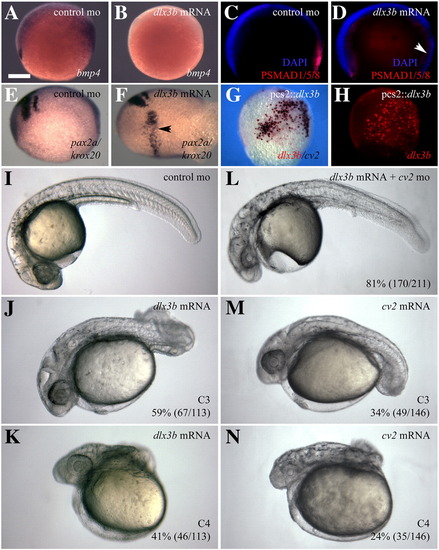Fig. 4
- ID
- ZDB-FIG-090113-12
- Publication
- Esterberg et al., 2009 - dlx3b/4b are required for the formation of the preplacodal region and otic placode through local modulation of BMP activity
- Other Figures
- All Figure Page
- Back to All Figure Page
|
dlx3b overexpression dorsalizes the zebrafish embryo. (A?D) Embryos ectopically expressing dlx3b mRNA display molecular read-outs consistent with reduced BMP activity. (A,B) bmp4 expression is reduced from the prechordal plate and tailbud of embryos ectopically expressing dlx3b (B). (C,D) Antibodies against PSMAD1/5/8 (red) reveal that BMP activity is reduced in embryos ectopically expressing dlx3b mRNA (D). (E,F) Riboprobes against krox20 and pax2a reveal a widening of the hindbrain in embryos ectopically expressing dlx3b mRNA (F). (G,H) Ectopic dlx3b DNA (red) can induce ectopic cv2 expression (purple). (I?N) Ectopic expression of dlx3b mRNA resembles the dorsalization seen in embryos ectopically expressing cv2. Knockdown of Cv2 can rescue the dorsalization seen in 81% (170/211) of embryos ectopically expressing dlx3b mRNA (L). (I?N) 30 hpf embryos; lateral views, with anterior to the left. Embryos were grouped into dorsalization categories based on previous classifications ([Kishimoto et al., 1997] and [Mullins et al., 1996]). (A?F) Bud stage embryos. Lateral views, with anterior to the left. (G,H) 80% epiboly embryos; lateral views, with ventral to the left. |
| Genes: | |
|---|---|
| Antibody: | |
| Fish: | |
| Anatomical Terms: | |
| Stage: | Bud |
Reprinted from Developmental Biology, 325(1), Esterberg, R., and Fritz, A., dlx3b/4b are required for the formation of the preplacodal region and otic placode through local modulation of BMP activity, 189-199, Copyright (2009) with permission from Elsevier. Full text @ Dev. Biol.

